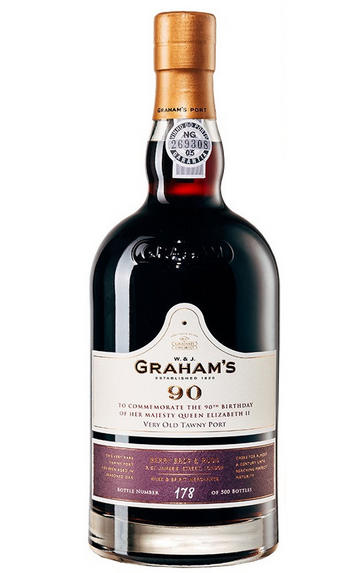
Graham's 90, Very Old Tawny Port
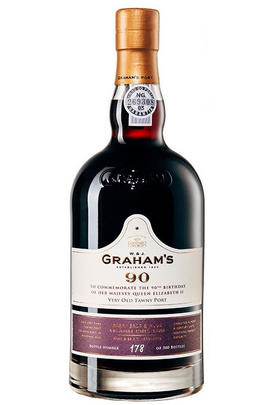
Critics reviews
Mark Squires - 28/10/2016
About this WINE
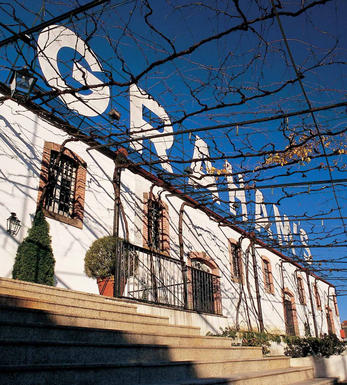
Graham
W & J Graham was originally a Glasgow-based textiles firm, founded by two brothers William and John Graham, which became port shippers in the early 1800s. The family already had extensive business interests in Scotland and India but they decided to channel their considerable resources and energy towards the pursuit of the Port industry.
Later that century, a young Scot called Andrew James Symington emigrated to work for Graham's, but, losing interest in textiles, he became a successful port shipper and his descendants today now own Graham's, which is the jewel in the crown of the Symington Group.
The Symington family’s ancestry in the Port trade spans a period of over 350 years, through 13 generations with 5 members of the family currently actively involved in Graham’s day to day management.
Throughout the 19th century Grahams rapidly grew and went from strength to strength and in 1980 they became one of the first Port companies to invest in Upper Douro vineyards with the acquisition of Quinta dos Malvedos. Since then Quinta dos Malvedos has been recognized as one of the Douro Valleys finest ‘river quintas’.
The Port wines from Quinta dos Malvedos form the backbone of Graham’s renowned Vintage Port in declared years. The vineyard produces Ports with floral characteristics, opulent blackberry fruit aromas backed by well balanced tannins.
Graham's Vintage Ports are the epitome of richness and concentration, and this is reflected right through their range of wines from ruby to vintage classics. They are Port wines with innate quality and potential for long-term ageing.
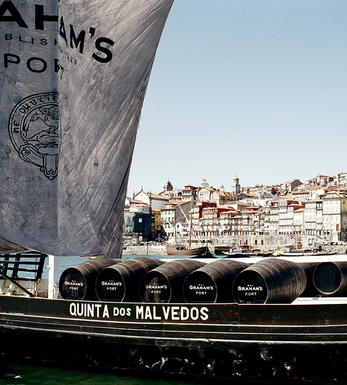
Vintage Port
Vintage Port accounts for only a small percentage of the total Port production - which includes Tawny, Ruby, Late Bottled Vintage, Single Quinta Vintage styles, among others - but is the finest, longest-lived and most expensive style that is produced. The best are as good as any wine in existence.
With the exception of legendary vineyards like Quinta do Noval Nacional and Quinta do Vesuvio, Vintage Port is made from a blend of wines from a producer's finest plots. It is aged for around 18 months in wooden casks before bottling; from then on the watch-word is patience. At least 15 years ageing – and for the top wines it will be significantly longer – is required before the tannins, spirit and fruit are fully integrated. Indeed, the finest examples can last well over 50 years.
Vintage Port is only made in exceptional years (normally around three times per decade) with considerable stylistic variation between different years and shippers. However, they all share a sweet, warming, spicy richness, power and complexity. In other good but not great vintages, many shippers produce a Single Quinta Vintage Port from their finest vineyard. These are made in the same way and have the same style as Vintage Port but tend to mature faster and are less profound. All Vintage Port throws a sediment as it matures, and thus requires decanting.
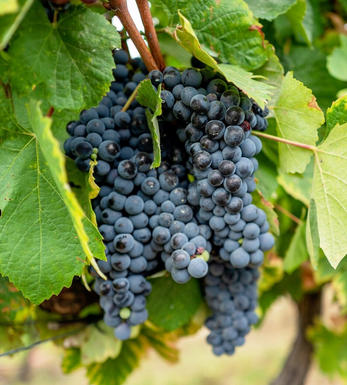
Port Blend
There are around 40 different grape varieties permitted in the production of Port - however the vast majority of Ports are produced from a blend of 5 grapes - Touriga Nacional, Touriga Francesca, Tinta Barroca, Tinta Roriz, and Tinto Cão.
Touriga Nacional produces small, dark-skinned grapes that produce opaque black wines of great extract and high tannins - it gives grip, body, and structure to the blend.
Touriga Franca has a thinner skin and consequently produces wines lighter in colour and tannins than Touriga Nacional. It contributes fruit, aroma, suppleness and roundness.
Tinta Roriz is the Portuguese name for Tempranillo and its high sugar content and low acidity contribute colour and fruit.
Tinta Barroca which is normally grown at highish altitudes and on north-facing slopes, is prized for producing wines of delicacy, finesse and with smooth, velvety fruit. It brings elegance and sweet, ripe fruit to the final blend.
Finally Tinto Cão produces fine and complex wines, though it is probably the least important of the 5 grapes as its painfully small yields have reduced plantings to almost insignificant levels.


Buying options
Add to wishlist
Description
A triptych of vintages underwrite this outstanding wine, each embellishing the ensemble with its own personality, the deep colour and firm acidity of the 1935 complementing the richly honied and hedonistic 1924 and the extraordinary intensity of the 1912 crowning the edifice and ensuring that the whole is far far greater than the sum of its parts.
Poised behind its deep mahogany sheen, with aromatics of the Coffee House in St James's and the post prandial dining rooms of Pall Mall, the wine descants a rich rolling hymn to longevity and extraordinary complexity. Cloves, raisins, dates and elusive spices inform a palate which is a labyrinthine web of effortless contradiction; rich and restrained, intense and ethereal, venerable and yet incredibly fresh. To be celebrated and appreciated in equal measure, with quiet stentorian gratitude.
Simon Field MW - Port Buyer
Three exceptional and rare wines were chosen for the final Graham’s 90 blend described by the Symington family thus: Harvest 1935
The 1935 Tawny Port is a wine of remarkable elegance and beauty with fine acidity which is key to the balance of a wine of this age. This was a year of low yields in the Douro but of great quality, and classic Vintage Ports were made under perfect harvest conditions. Some Port companies declared the 1934 and some the 1935. Both years have proved to have aged superbly well.
The 1935 Vintage is considered by some to be amongst the greatest Ports of the first half of the 20th century. Andrew James Symington wrote at Quinta do Bomfim in the Alto Douro on 14th October 1935: “I am inclined to think that the quality and good colour inspires hope that the 1935 may prove good enough to make a Jubilee vintage – quantity is less than last year – but quality appears to be better.”
The three Symington brothers then working in the family business; Maurice, John and Ronald and their father Andrew James, did not declare this year, but they set aside a small quantity of 1935 Port to age in cask in view of the excellent quality of the best wines and to mark the Jubilee of King George V.
Charles has selected a small parcel of this extraordinary wine for the Graham’s 90.
Harvest 1924
The 1924 Vintage was widely declared by the leading Port houses and the wines have aged exceptionally well over the decades. An unusually cool summer resulted in wines with very good acidity, a hallmark of the year.
Gordon Cosens wrote at Quinta do Bomfim in the Alto Douro on the 10th October 1924: “Weather being fine throughout the gathering. The mostos showed good colour and life. That the '24s will turn out to be better than an ordinary vintage seems to be the general opinion.”
This 1924 Tawny Port originates from Quinta do Bom Retiro Pequeno, a very fine vineyard in the Rio Torto valley that is owned by the Symington family. Matured in cask at the estate until the mid-1960s, this Po Harvest 1912
A great classic year in the Douro that followed two legendary vintages, the 1904 and the immortal 1908. Widely declared by the best Port houses, the 1912 vintage Ports were bottled in the spring of 1914, just a few months before the outbreak of hostilities in August of that year. Although it’s early life was marked by the devastation of The Great War, this wine reached maturity in the late 1920s when it came to be recognised as one of the greatest ever Vintage Ports and was often served at fine dinners in the exuberant Roaring Twenties.
Amyas Warre (son of George Warre) wrote at Quinta do Bomfim in the Alto Douro on 23rd September 1912: “The grapes in all the fine vineyards were uniformly ripe and had all been gradually brought to this state of perfection.” This was an historic year for the Symington family as George Warre, whose family had been Port producers since 1729, decided to retire to England in 1912 and proposed a merger of Dow’s with the smaller Port company of Warre’s, the latter being then owned by Andrew James Symington.
Andrew accepted the proposal, initiating a partnership between the two families that was to last until the 1950s when the Warre family sold their remaining shares to the Symingtons. To mark the start of the partnership a small parcel of the 1912 Port was set aside in cask and it is a little of this wine that has been used by Charles in the Graham’s 90 Port.
The 1912 Tawny has extraordinary intensity having passed its centenary a few years ago and Charles Symington felt that this essence of well-aged Port would complement the elegant freshness of the 1935 Tawny.
wine at a glance
Delivery and quality guarantee